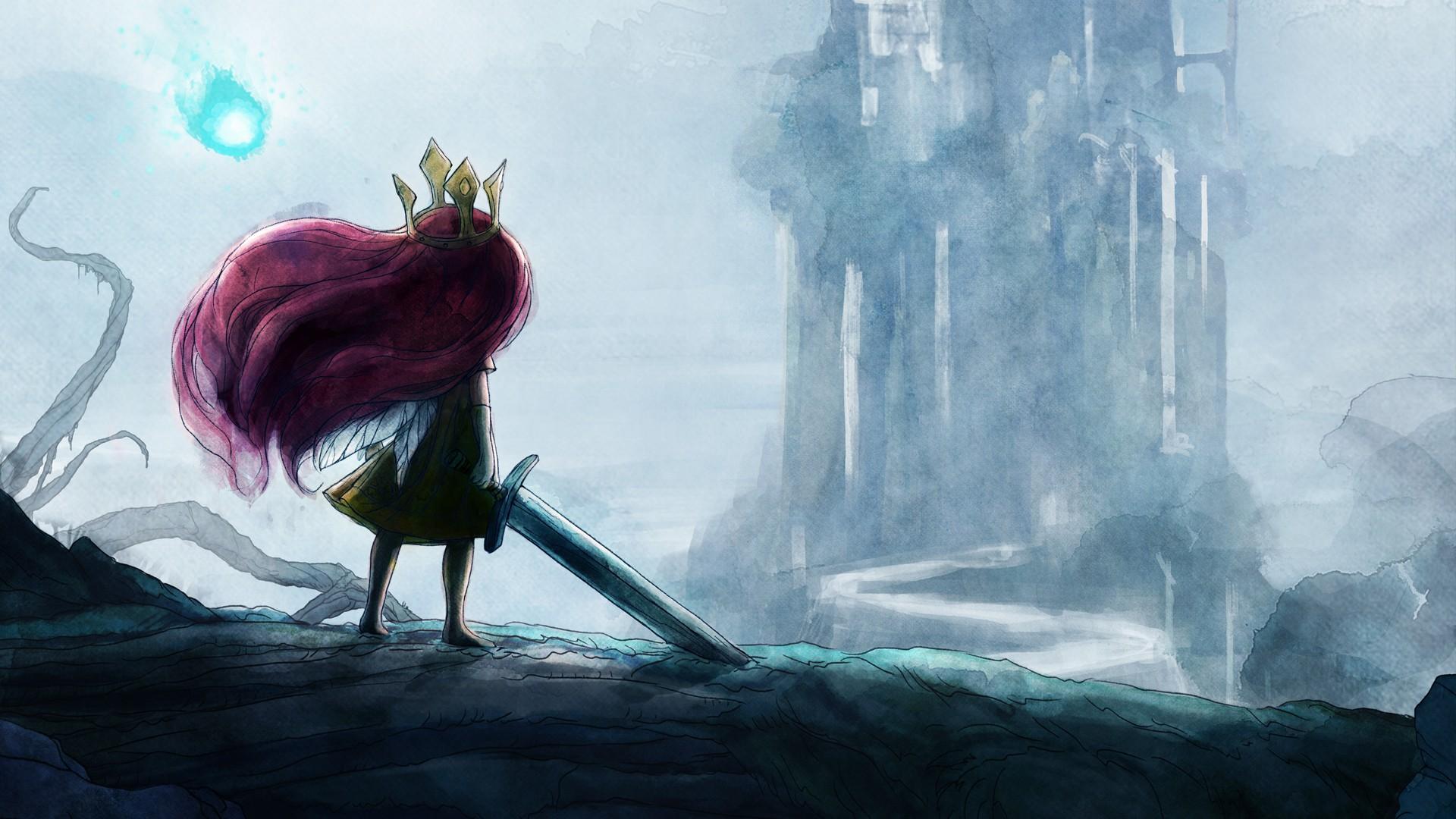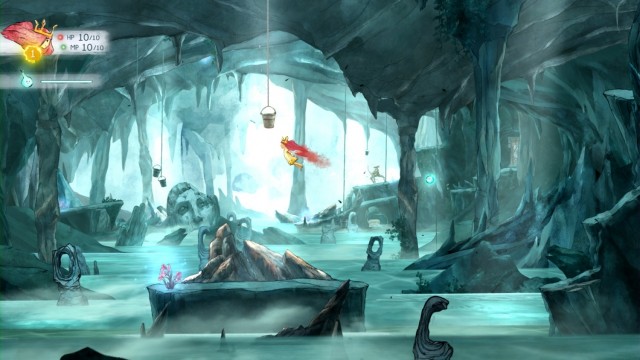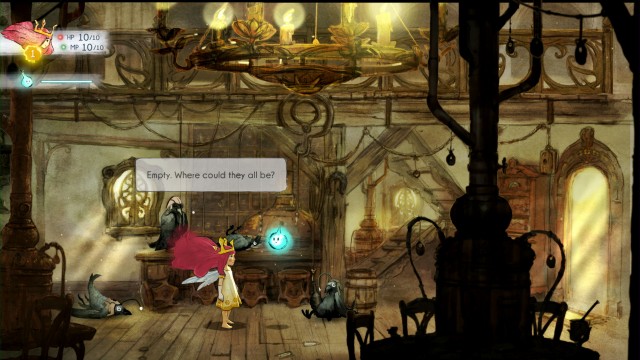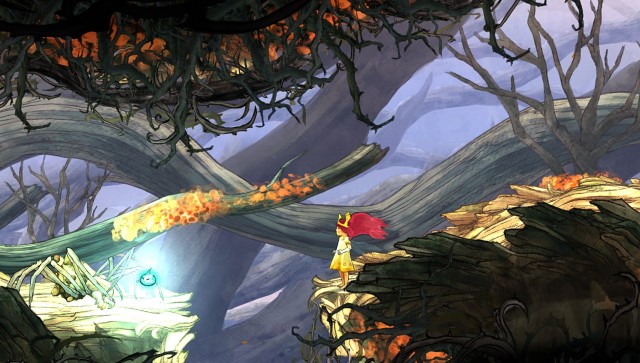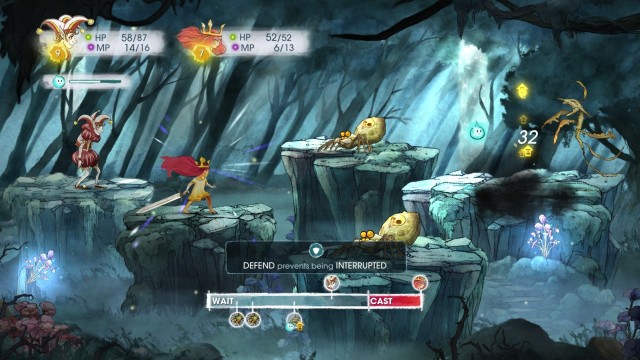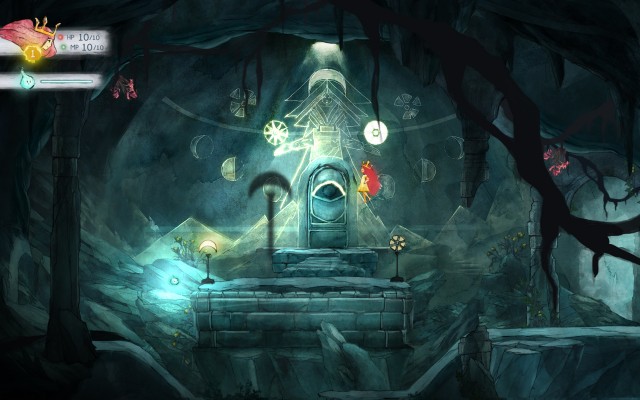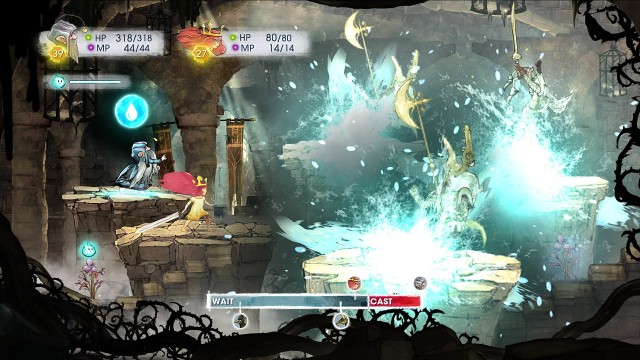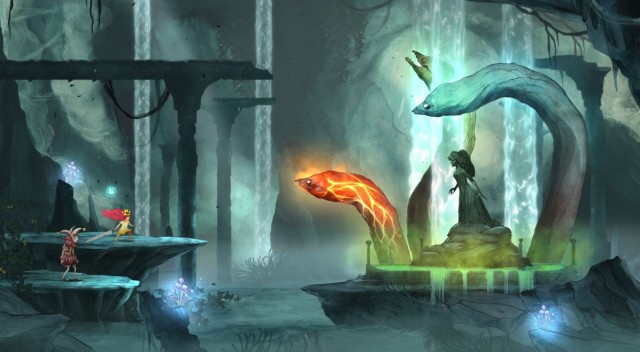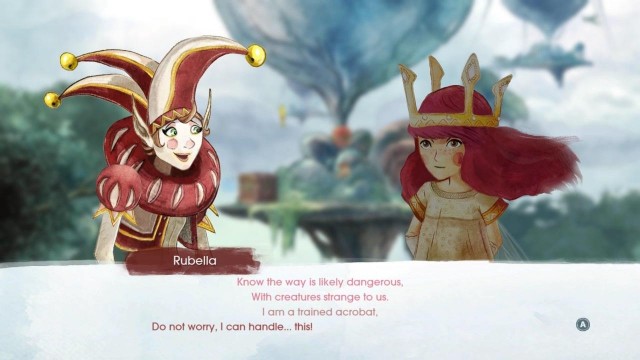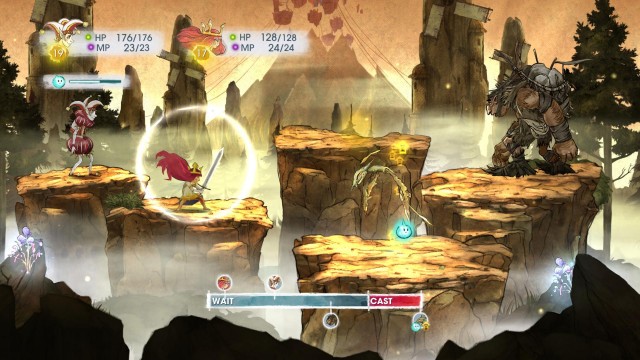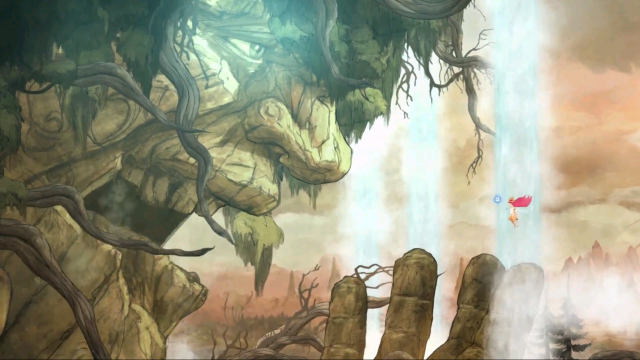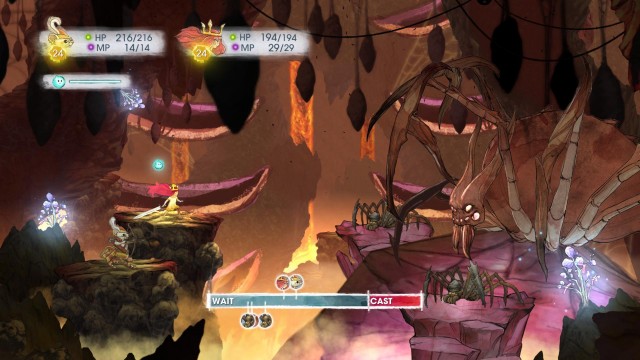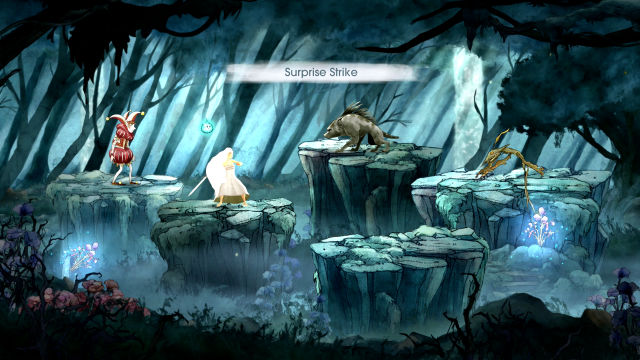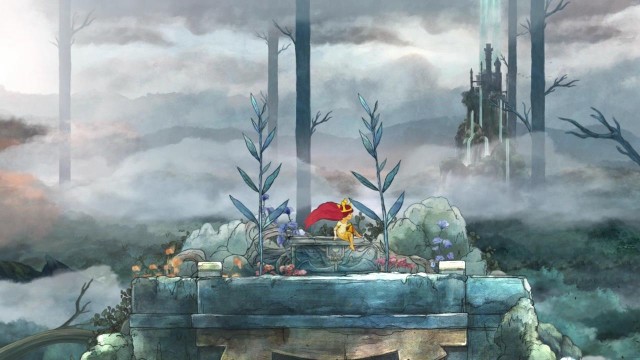Child of Light will remind many an RPG gamer as to why they fell in love with the genre in the first place.
There’s a very innocent, playful feel to what’s at heart a very dramatic and almost melancholy story. This, paired with the beautiful UbiArt Framework-powered visuals and the mellow, soothing soundtrack make for an experience that feels undeniably beautiful in every possible sense, while also successfully pulling off a smaller scope for what’s otherwise a genre full of very grand experiences.
Essentially, Child of Light succeeds as one of this year’s standout digital download games, simply because it so effectively immerses players in a sense of beauty and wonder. On top of that, it also tinkers with the traditional console-style RPG formula just enough to stand apart as its own noteworthy experience, perfectly bridging the gap between convention and innovation.
There may be a few shortcomings here and there, and the newly-released PS Vita port is particularly suspect, but Child of Light demands to be experienced by anyone willing to appreciate a charming and unique adventure.
Child of Light builds upon the hand-drawn aesthetic of the UbiArt Framework engine, which, despite its fantastical stylings, nonetheless has the rare distinction of easily being able to deliver native 1080p HD resolution and steady 60fps framerates on even last-gen consoles, as evidenced by the stellar Rayman Origins and even more stellar Rayman Legends. Needless to say, it looks breathtaking as well.
From the freely-flowing hair of protagonist, Aurora, to the gusts of blustering wind currents, to the shine and searing of the game’s especially excellent lighting effects, Child of Light bears a colourful style that’s entirely in a class of its own. The game animates like a gorgeous watercolour painting that is coming to life before the player’s eyes, and at native 1080p resolution, Child of Light is especially successful at actually stirring player emotion and investment even by the lone basis of its art style!
Somewhat frustratingly however, it’s only the next-gen versions of Child of Light that stand at native 1080p resolution. This could be to emphasize the new technology in the next-gen consoles, but it’s disappointing that such a visually flexible game engine as UbiArt Framework has been capped at 720p on Xbox 360, PS3 and Wii U, seemingly inexplicably. The game still looks incredible on those platforms, but is noticeably less detailed and colourful on them than it is on PS4, Xbox One and optimal PC settings.
The visuals only get more compromised on PS Vita to boot. The resolution is extensively compressed to fit the Vita screen, to the point where everything just feels too small to adequately pop out of the display, the way it would with far more effectiveness in the console and PC builds. On top of that, the PS Vita build’s less steady framerate is more inclined to dip and cause slowdown, since a game this visually ambitious is clearly taxing the handheld. It’s still a very good-looking Vita game, but Rayman Origins and Rayman Legends definitely turned out better porting jobs on Sony’s handheld.
As for performance in the other versions, Child of Light is generally pretty smooth and steady on all six of its other platforms. Even the last-gen builds on Xbox 360 and PS3 never struggle to animate or perform with consistent quality. The Xbox One version does see small, barely noticeable framerate hiccups every now and again, but they’re pretty well microscopic, and shouldn’t be anything resembling an issue for those wanting to play the game on Microsoft’s next-gen console.
The Xbox One version of Child of Light at least compensates by being a bit sharper and having slightly better colour contrast, lighting and particle effects than its PS4 counterpart. The PS4 version is a bit more stable and a bit less harsh on the eyes, but the Xbox One version’s added sharpness is still worth noting, even if the PS4 version plays a tad more reliably.
On PC, Child of Light stands effortlessly with the PS4 and Xbox One versions visually on optimal settings, and may even slightly edge them out if your rig is especially powerful. This being a Ubisoft game however, the PC port, while one of Ubisoft’s better PC ports, granted, is still kind of lazy. The PC version completely lacks the ability to alter v-sync and framerate, and merely allows players to toggle resolution, brightness and fluid simulation, with no other customization options at all. It also contains a bit of screen-tearing that isn’t present in the other versions.
If next-gen isn’t an option for you, at least Child of Light feels very smooth and well-realized on last-gen platforms and Wii U. There’s pretty well no discernable difference in visual performance at all in the Xbox 360 and PS3 versions, which seem to look and play completely identically. The 720p cap is a disappointment, but at least you’re still getting a steady and visually striking game for those platforms’ standards regardless.
The Wii U version at the very least does have a slight visual leg-up on the Xbox 360 and PS3 builds of Child of Light. It’s still needlessly capped at 720p though, which is annoying, especially given the Wii U’s effortless native 1080p capabilities in almost all of its other games. Even so, lighting and colour effects are a mite sharper on Wii U than they are on Xbox 360 and PS3, with framerate and performance also being a perfectly consistent 60fps at all times on Nintendo’s console. The game suffers nary a visual compromise when played on the Wii U Gamepad as well, which is excellent.
As much as there are differences and certain compromises between platforms however, depending on your platform of choice and the technology available to you, Child of Light still looks consistently captivating on any platform. Even given its smaller quest compared to most other console-style RPG’s, its vast and poetic landscapes, deadly, exotic monsters and wondrous, awe-inspiring magic will never cease to be a treat for the eyes!
Most of Child of Light’s adventure is backed entirely by gentle piano tunes. It’s a very quiet, solemn soundtrack all around, one that contributes to giving Child of Light a sense of poetry and delicate beauty.
The battle themes at the very least are a little more lively. The piano tunes are now complemented by strings, and occasionally triumphant choruses as players engage menacing bosses in particular, though even the more understated main battle themes against normal enemies still sound engaging, while maintaining the majestic inspiration of the rest of the soundtrack. It’s very Final Fantasy-esque, with an added poetic slant, which is appropriate, since retro Final Fantasy games were a heavy inspiration for Child of Light in general.
Fortunately, modern production values have allowed the sound effects to really sing in a way that they never quite could in old-school Final Fantasy. There’s a satisfying surge of power with every weapon strike, spell crackle and stat-reducing hex flung in battle, just as the sound of Aurora’s wings carrying her through windy plains and dank tunnels gives players an effective sense of freedom that most other RPG’s don’t quite offer.
Given the rest of the great audio work then, it’s a bit of a shame that the dialogue between characters is exclusively conveyed through quiet text. A young woman narrates certain exposition scenes at rare instances in the game, but that’s the only point where you’ll hear any voice acting. It’s a shame that some voice actors couldn’t bring Child of Light’s loveable cast of characters to an even greater degree of life.
Ultimately though, that’s a nitpick. The fact remains that Child of Light still has the same air of beauty in its audio as it does in its visuals, throughout the entirety of its quest.
While Child of Light is mostly a traditional console-style RPG, it also borrows a few elements from platformers and open-world adventure games as well.
The game unfolds in a 2D landscape, with players initially able to run and jump around, akin to a grounded 2D platformer. Early in the game however, your protagonist, Aurora will gain access to wings, and for the vast majority of the experience, you’ll be able to use these wings to fly around in any 2D direction at will.
Aurora’s wings allow her to freely move about wherever the player wishes, again, making you feel more free and uninhibited than most other RPG designs allow. There’s nowhere in the lush 2D watercolour landscapes that you can’t fly to, nor is there some arbitrary flight meter restricting your movement. Sure, some hazards like prickly thorns and jabbing blades may occasionally need to be timed to avoid the loss of HP by a wrong move, but for the most part, Aurora can freely and quickly move anywhere thanks to her wings, which is a unique and surprisingly ingenious way for players to navigate the game’s setting of Lemuria.
Even with Aurora’s incredible mobility however, there will still be certain places that she’s too large to squeeze into, or may wish to avoid for want of provoking a monster. Fortunately, she has a firefly-esque spirit companion, Igniculus, who can pick up items and HP/MP-restoring wishes in her stead, as well as shine himself in the face of enemies to allow Aurora to either sneak by, or ambush them. Igniculus can even heal Aurora and your other party members by shining on them both in and out of battle, though bear in mind that he has a limited ‘Light Meter’ that can be drained, and must be recharged by picking up light energy from flowers both in the field and on battle screens.
Igniculus is also often used in puzzles as well. Sure, most involve simplistic block and switch puzzles with Aurora, though a few obstacles also force players to use Igniculus’ light to align shadows and runes in order to unlock new paths. The puzzle design is never complicated, but at least it’s not intrusive, and helps to give Child of Light a bit of welcome adventure gaming elements.
Igniculus can be moved with the right stick on any platform, or the mouse if you’re opting to play with a keyboard in the PC version, which does also support gamepads, including an Xbox 360/Xbox One controller. In fact, on this note, certain versions of Child of Light may be more appealing than others to players who prioritize control flexibility, since controlling Igniculus with the right stick is functional, though a bit sluggish and far from ideal, which is especially a problem if you opt to play on the harder difficulty, where careful use of Igniculus in battle is all the more important.
Unfortunately, Igniculus can only be moved with the right stick on Xbox 360, Xbox One and PS3, so you’ll just have to get used to that method in those versions of the game. Moving him with the mouse does work quite well on PC, though many PC players will probably prefer to use a gamepad, since Child of Light is primarily designed for consoles, likely eliminating the mouse option for would-be PC players.
Fortunately, specialty control gives you a lot more accuracy and agility when moving Igniculus in the remaining versions. The ability to move Igniculus with the touch pad on PS4 is a huge draw in that version compared to its Xbox One competitor for early next-gen adopters, and even the shakier PS Vita port effectively allows you to easily slide and teleport Igniculus around using the handheld’s touch screen. Likewise, the touch screen on the Wii U Gamepad makes navigating Igniculus on the Wii U especially easy and precise, whether you’re playing on the television or the Wii U Gamepad screen.
A second player does have the option of controlling Igniculus themselves locally in any version of Child of Light, except for the PS Vita version obviously, and this does effectively present a decent way for less skilled or younger players to participate in the game. It works especially smoothly in the Wii U version as well, since a second player can easily point and use Igniculus with a Wii Remote in that case. This optional two-player mechanic boils down to a glorified ‘Assist Mode’ that serious gaming second players won’t find appealing at all, but the inclusion in the console and PC builds of Child of Light is nonetheless appreciated.
As useful as Igniculus is as a way to help pick up items and distract enemies in the field, it’s within battle that he truly becomes a cool and noteworthy mechanic. Depending on where and how you direct Igniculus around, you can use him to slow down enemies or gradually heal your party members, even in menus, as long as he has Light Energy to spare.
Combat is a big centerpiece in general within Child of Light however. Battles are not random, with enemies being visible on the field, in turn allowing Aurora and her allies a free hit if they sneak up behind them, but also forcing the good guys to suffer an extra round of attacks if an enemy approaches them from behind as well. You can use Igniculus’ light to temporarily blind monsters to better ambush them, or just sneak by them entirely, though obviously, it’s best to fight all the monsters you encounter to keep your party strong and their levels high for the battles ahead.
Once combat is initiated, it flows in a turn-based style, somewhat reminsicent of the active-time battle system from the older Final Fantasy games on Super NES and PlayStation. Both allies and enemies move along a scale, and are able to act when they reach the end of that scale. Players are allowed two party members at once as well, and can freely swap out a fighter without missing a turn, though they will sacrifice a turn if they use the opposite character’s turn to swap out a separate character, if that makes sense.
Where the twist comes in is the ability to use Igniculus to slow down monsters, making their icons move slower on the scale, and potentially allowing your party to attack more frequently. That’s not all though! There’s a red bar at the end of the turn scale that players need to watch for after they choose a command. If an ally or enemy alike is hit when they’re in this red ‘Cast’ scale, with certain attacks and functions taking longer to move along the red scale than others, they’ll be knocked back on the scale, and their turn will be cancelled!
This adds a very cool new element of strategy to battle, especially on the harder difficulty setting. Proper use of Igniculus in the game’s tougher battles is key to being able to attack and interrupt enemies regularly, which can drastically shift the advantage in battle, depending on how well you can cancel enemies’ turns without them cancelling yours. There is a way to protect your party members from interruptions using certain spells and items, and certain enemies counter interruptions with unique and sometimes devastating attacks, but these simply add even more effective options to what’s a simple, but very inspired turn-based battle system.
You can further influence your party members’ stats and the flow of battle by equipping them with Oculi as well, which are gems that you find either dropped from enemies, within treasure chests throughout Lemuria, or as rewards for completing optional side quests from certain folks in need. Each character has an attack slot, defense slot and support slot for Oculi, which can add elemental properties to a character’s physical attacks, reduce certain elemental damage, alter stats, give support functions, and even increase the amount of EXP won from battle, depending on what you equip.
Players also have the ability to blend two or three Oculi together via a simple crafting system, which lets them forge better Oculi to better outfit their party members. You can even send Oculi as gifts to UPlay friends if you wish, or purchase it with real money using online microtransactions, though neither is really necessary, since Lemuria has more than enough Oculi to carry you through the game if you’re at least somewhat thorough with exploring. Even with no shops or currency in Child of Light, a rarity in RPG’s, you’ll still feel that you have plenty of means to develop your characters as you see fit.
This is especially true with how easily you’ll level up your characters, as long as you don’t get lazy with fighting monsters as well. You may need to grind for EXP a bit on the higher difficulty, but on the normal Casual setting, you’ll be fine as long as you don’t skimp on fighting enemies. As your party expands, at least one character will likely gain a level with each battle, with your entire party no doubt building levels with the hefty amount of EXP that bosses dole out after being defeated!
Not only does levelling up build your characters’ stats, as with pretty much any RPG, but it also awards Skill Points. Skill Points can be spent on one of several unique paths for each character, unlocking more stat boosts, new spells and abilities, or even things like the ability to use an attack or spell on all available targets, or perhaps boost the effectiveness of skills you already have. Again, it’s a very simple system, but one that works incredibly well, and still allows players the freedom to develop the kind of characters that they would prefer to have in an RPG.
Essentially, Child of Light effectively proves that play design wins out over scope, even in RPG’s. It’s very short for an RPG, and can be completed pretty easily in about 12-15 hours, perhaps even 10 hours if you rush through it on the Casual setting.
With that smaller package however, Child of Light cuts out the fluff and tedium that is often present in other RPG’s that are trying to pad out their playtime. Child of Light instead focuses on delivering a tight, well-paced adventure that will be consistently exciting and engrossing for RPG fans, even if it’s shorter-lived.
While RPG fans will undoubtedly get the most out of the game’s experience, you don’t necessarily have to play RPG’s, or even know anything about them at all, to effectively enjoy Child of Light. It’s a very inviting game to people who want to get their feet wet in the RPG genre, or simply appreciate fantastical, poetic game experiences of any sort. Its mechanics are accessible and easy to understand for anyone, but they also offer great depth and flexibility in terms of combat and character customization, without letting the experience become intimidating at any point.
As much as Child of Light is rooted in retro RPG convention, it will make you question your definition of what makes a good RPG, albeit in a great way. Even being shorter and smaller in scale than most other offerings in the genre, the gameplay experience will feel richer and more fulfilling than much of the competition, creating a wonderfully unique and subversive Ubisoft game experience that stands effectively apart from anything else that the French mega-publisher has ever done.
Child of Light tells a pretty simple tale, despite its abstract presentation.
Players control Aurora, a young Austrian girl who appears to be near death from illness, but soon after awakens in a strange land. Meeting a young light spirit, Igniculus, Aurora learns that she is in Lemuria, a gorgeous, whimsical world that exists parallel to the real world. As she attempts to find her way home, she interacts with and befriends many of Lemuria’s citizens, and learns of the plight facing the land, which is being threatened by the evil queen of darkness, Umbra. From there, it’s a pretty simple good-vs.-evil conflict in the end, though one that still manages many charming and emotional moments.
What separates Child of Light in terms of its storytelling however is a rather unusual quirk; Every character speaks in rhyme. Even the narrator speaks in rhyme. There’s one character in your party that botches rhymes continually as a running gag, and she’s seen to be some sort of weirdo. Yes, it’s as if Dr. Seuss himself wrote Child of Light, believe it or not!
On the one hand, this helps to further a feeling of being innocent and playful, unfolding as a grand, harrowing tale seen through the eyes of a small, naive child. It undeniably works to a point, and on its own merits, it’s pretty darned cute when it’s really done well.
On the other hand however, some of the rhymes are laboured at best and genuinely eye-rolling at worst. Not every dialogue exchange is easy to adequately understand because of the occasionally forced rhyming either. Sometimes, you’ll have to re-read the text of even major plot turns, just to maintain a clear grasp of which sentiments the characters are actually expressing, and what they actually mean in terms of the progression of the game’s plot.
All in all though, Child of Light feels like a video game version of poetry, albeit sometimes awkward poetry. The events depicted therein are nothing you haven’t seen before in many other fantasy-themed adventures, but if nothing else, this is a story told with lots of heart and poignancy, even if you may sometimes wish that the characters would stop speaking as if they were in Whoville!
Even more commendable is the fact that this change is permanent as well! The character in question even serves as one of the game’s final bosses! Few RPG’s have the balls to make a character that you’ve come to trust, develop and even fight with for many hours turn out to be a major villain, one that you have to strike down later, and beyond the rhyming dialogue, this is perhaps the most ambitious element of Child of Light’s otherwise conventional RPG storytelling.
It’s still a bare-bones good-vs.-evil conflict by-and-large, but like I said, at least there’s a good amount of charm and emotional poignancy to keep the adventure’s stakes afloat.
Child of Light is a real gem. It’s a game made with tons of heart, plenty of inspiration, and no shortage of gorgeous, evocative charm.
If you’re turned off by turn-based combat and other such RPG convention, then Child of Light will likely still come off as dull to you. After all, it’s a game that’s much more concerned with being beautiful and emotionally stirring than it is being thrilling.
If you do appreciate a good, loveable fantasy adventure however, regardless of your prior RPG pedigree, Child of Light is an absolute must-play! Even with the game being far shorter than most other RPG’s, the $14.99 asking price is quite reasonable, especially since this game presents a welcome departure from Ubisoft’s usual slate of games.
Between its many platforms, the next-gen versions are ideal, but the last-gen versions are still the same game, with the same wonderful high points throughout. The visuals are best appreciated on PS4, Xbox One and PC, where they run at their best via native 1080p resolution, though the 720p-capped Xbox 360 and PS3 versions will still be great for RPG enthusiasts and fantasy lovers who haven’t yet upgraded their hardware. The Wii U version is also very well put-together for Nintendo gamers, and while it’s locked at 720p like the Xbox 360 and PS3 versions, the advantage of off-TV play and Wii U Gamepad navigation for Igniculus, on top of a small visual bump, gives Nintendo’s version a boost in recommendation over the last-gen consoles.
The belated PS Vita version of Child of Light does offer the advantage of portability, but be warned that this version is choppier, a bit less polished, and the least good-looking. It also continues to lack cross-buy and cross-play support, which is not available between PS3 and PS4 either, at least not outside of Europe, and the lack of cross-save capability with either the PS3 or PS4 version of the game is, frankly, rather disappointing. Unfortunately, even though it’s still a great game on Sony’s handheld, the PS Vita version of Child of Light is also the least recommendable.
For the best balance between play performance, visuals and perks, the PS4 version is the ideal build of Child of Light, so get that one if you have the option. The game is superb regardless of platform, but it shines best on PS4. The PC version comes a close second with its final product, even with its lack of customization settings, though be warned that, as with any Ubisoft game on PC, Child of Light is bound by the rather irritating UPlay DRM. That shouldn’t be a dealbreaker for avid PC gamers, but if you don’t enjoy gaming on your PC already, you’d no doubt be better served with any of the five console versions on offer.
In any case however, Child of Light, short-lived as it is, is a wonderful odyssey to a strange, yet incessantly captivating land. It’s a smaller adventure, but it’s still built with all of the fundamental ingredients that any great RPG is made of!

